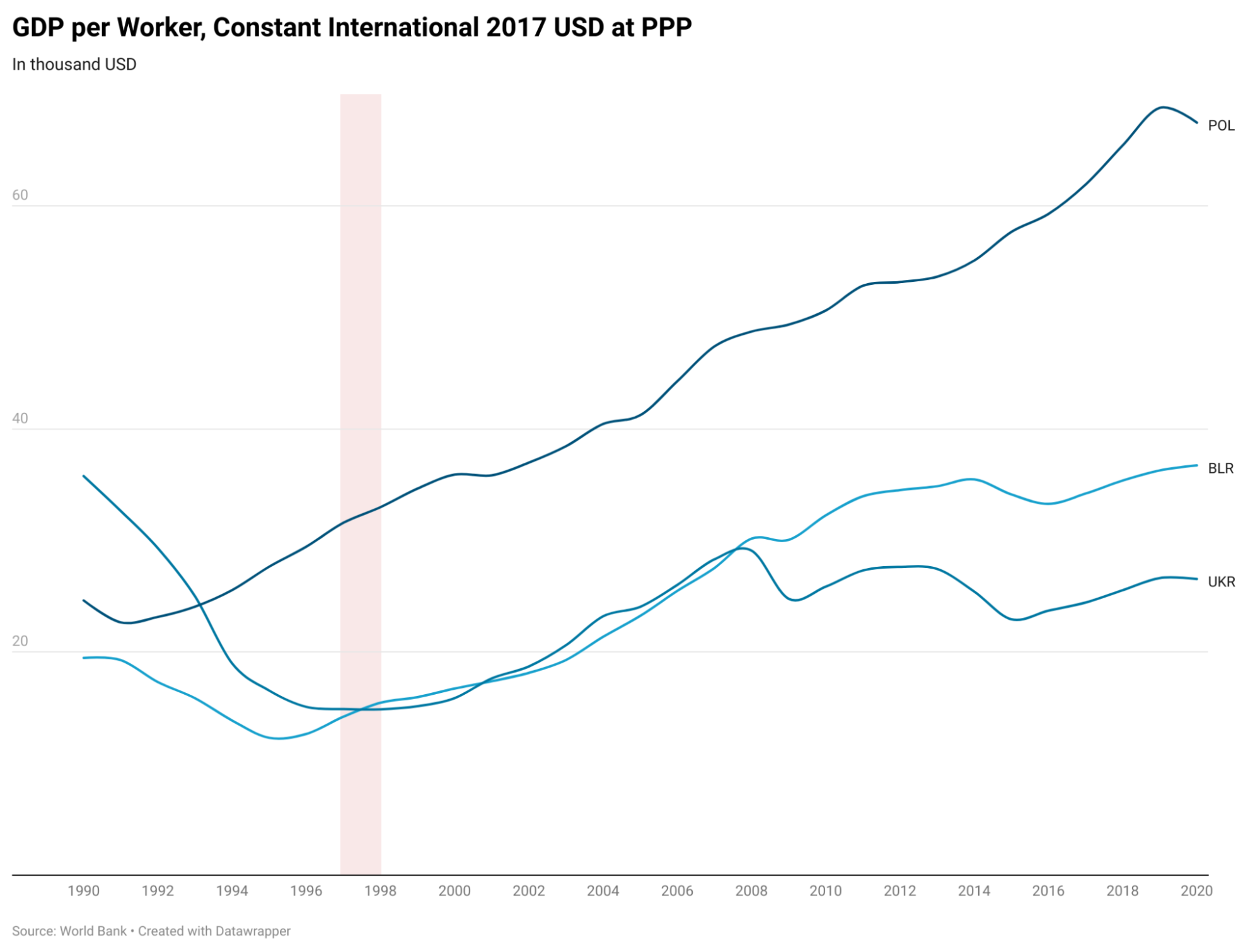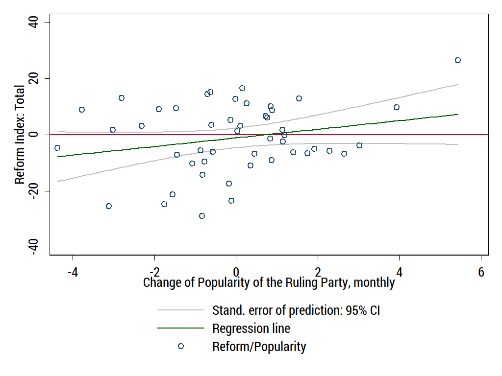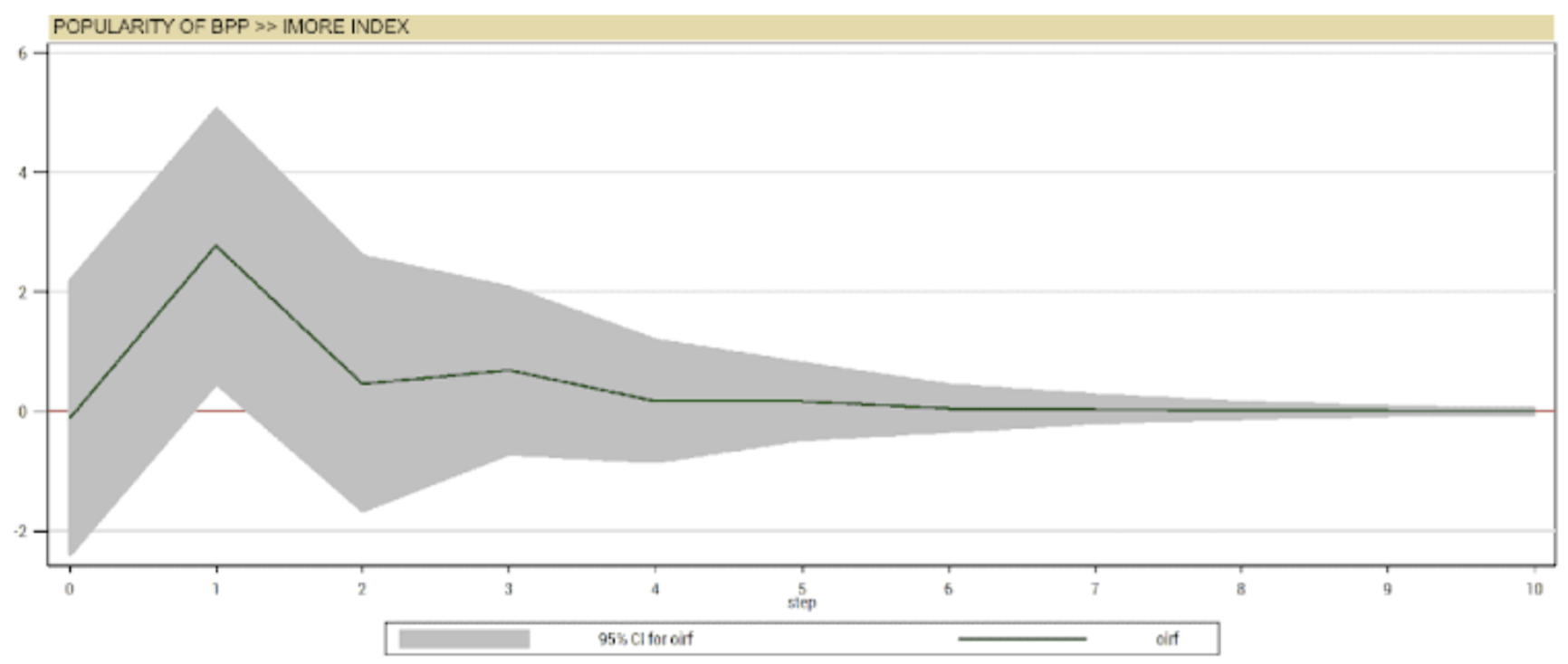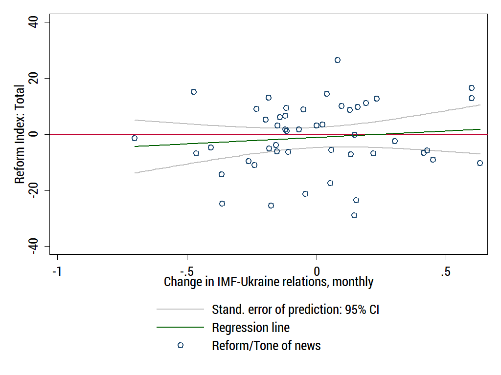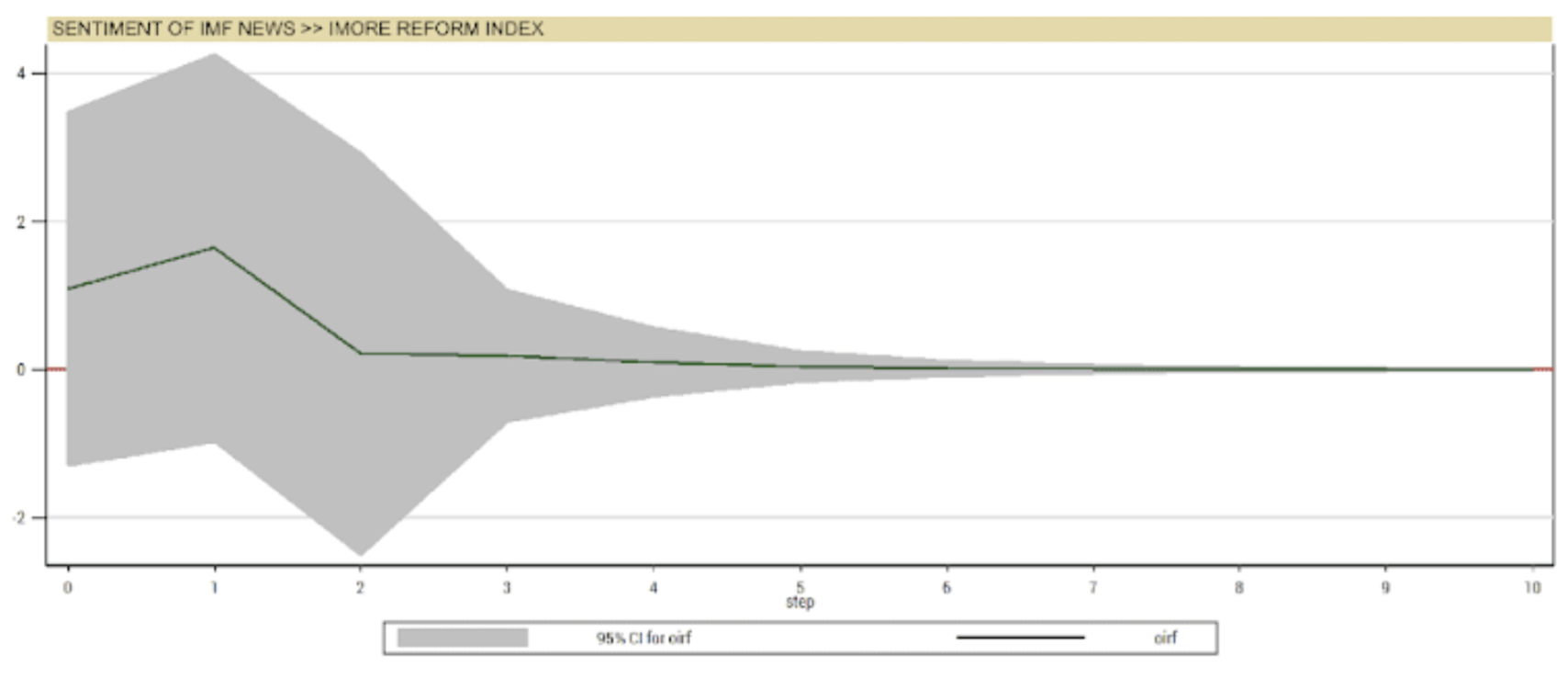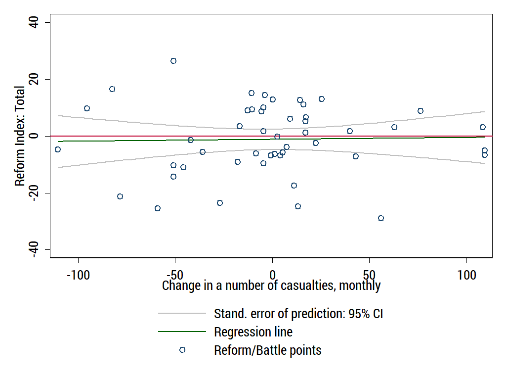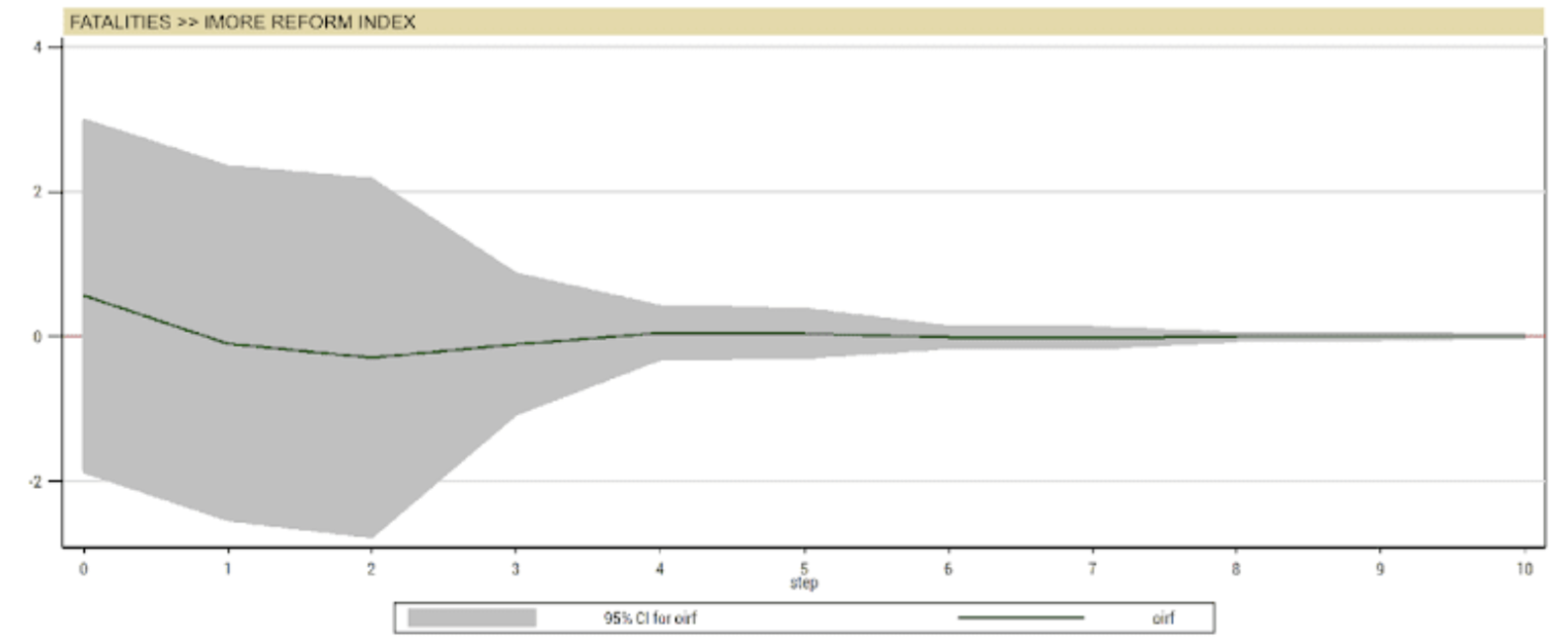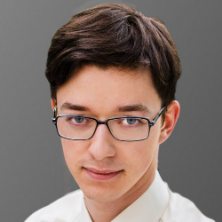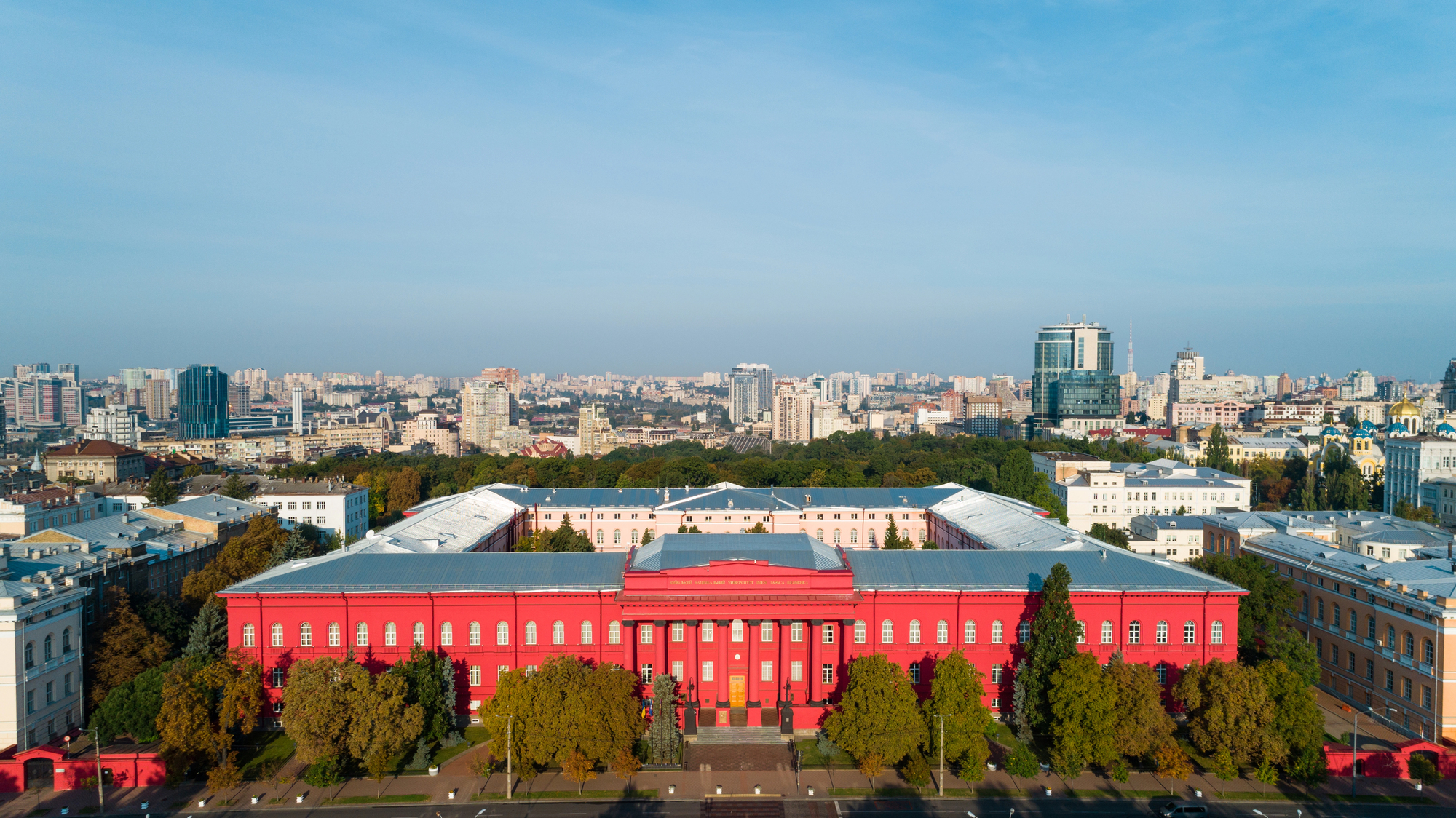Discussions about Ukraine’s continuing procrastination in implementation of the critical reforms feature many potential explanations. The most common ones include corrupt politics, lack of external support, and the destabilizing effect of war. This column confronts these explanations with data. Based on the results, the author argues that domestic politics is likely to be the strongest factor of all three and explains why external shocks are not systematically correlated with the reform progress.
The contemporary debates of the present-day economic performance in Ukraine frequently begin with the following question: how did the country that inherited a large share of Soviet industrial and scientific capacities perform so much worse than its neighbor countries? A statistical fact: while Ukraine productivity was 80% greater than in Belarus 30 years ago, it now falls short by more than 30%. Strikingly, this is not a recent development. As Figure 1 shows, productivity levels evened up already in 1997 with an ever-increasing gap starting from 2004. Although one may argue that Belarus was effectively a petrostate due to mass reexport of Russian oil products, this does not explain why Ukraine fell so much behind of countries like Poland.
Source: World Bank
Note: Number of workers represents the active labour force of the country of age 15 and older. Computed by the World Bank as total population times the share of the actively working population delivered by the International Labour Organisation based on representative nation-wide surveys.
Ukrainian Backwardness: The Big Three
With the body of knowledge accumulated over the last three decades, there is no shortage in possible explanations of Ukraine’s backwardness. In the early period of the post-communist transition, issues of macroeconomic stabilization (combating inflation and stabilizing government finance) and pro-competitive market-building were at the center of the advice. In the eyes of proponents of that approach, Poland was a success story that followed this approach. While tight monetary and fiscal policies assured a quick stabilization and a rebound in the early years, a quick implementation of pro-competitive policies assured a steady upward growth trend above the world’s average in the long-term.
Yet careful observers know that this explanation merely scratches the surface. For those living in the 1990s it was clear that macroeconomic stabilization was necessary to promote businesses based on long-term investment rather than on asset fire sales and fraud. Thus, the real question was not “what” but “why”: why elites don’t deliver for the common good? For instance, why it took almost twenty-five years and five presidents to make the National Bank of Ukraine start combating fraudulent business models of the largest Ukrainian banks?
There are plenty of explanations for this question as well. Factionalist politics with parties controlled by vested interests frequently appears on top of the list. Ukraine’s major governance structures – Rada in the first place – barely represented a place with a balanced dialogue between parties. Instead, it was a highly polarized political space with parties centered around personalities and financial donors. In this environment, it was tempting for politicians to pick up populist rhetoric and devote more time to securing privileges of industrial lobbies rather than fighting monopoly powers and installing transparent mechanisms for procurement of public goods.
Some claim that the issue could have been mitigated if the role of the EU, US or international institutions had been stronger. Unlike countries like Poland, which had a tangible prospect of EU membership on a distance of a decade, this was not the case for Ukraine. The accession process would not only help support reforms through adoption of regulatory standards and finance from convergence funds, it could promote continuity of the Ukrainian development agenda by consolidating elites through a common vision of the future.
Finally, when it comes to the post-2014 history, one can hardly avoid the elephant in the room: the war. It appears natural to see it as the key impediment to Ukraine’s development of the last eight years. War inflicts direct damage to humans and production capacities (see here or here for estimations done specifically for Ukraine). It scares away investment, diverts resources from productive activities into military, and motivates outward migration of the most active and qualified people. When survival is at stake, one can hardly expect policymakers to pursue long-term development problems.
Mirror, mirror on the wall, who is the strongest of them all?
All lines of reasoning outlined above sound legit. The question is, however, how well do they stand when confronted with data? In a recent paper I put these hypotheses to a test in the context of the Poroshenko presidentship from April 2015 to April 2019.
This timeframe is well-suited for checking supporting evidence in favor of all explanations outlined above. First, it was a period with a considerable variation in the reform process starting from the relatively high levels in 2015 to point zero by early 2019. Second, it was characterized by strong political competition between the parties that led to an effective break-up of the ruling coalition and political deadlock in 2016. Third, it was a time of active IMF participation, which used credit conditionality to push a few major reform tracks such as reform of banking supervision and energy market. Finally, the period witnessed swings in fighting intensity. Although the level of fighting after March 2015 never moved even remotely close to the all-time highs of 2014, it still was much more intense than the present-day levels. For example, fifty fatalities per month were quite common in 2015 but would be an outlier in 2019 when the count rarely exceeded twenty combatants during the same period.
It is worth noting that collecting the data required compilation of several new datasets together with extensive preprocessing of available time-series beyond standard techniques like outlier removal and computation of differences between time periods. For example, to compile sentiment data on the IMF news, I applied fairly complicated intermediate steps, which involved application of classification algorithms. Table 1 below concisely summarizes the processing steps and data sources to provide an overall picture without getting too technical. I recommend interested readers, however, to consult with the original paper to get full details of the data collection process.
Table 1. Summary of data series used in the study
| Indicator | Measure of | Collection and adjustment process | Original source |
| Reform Index | Commitment to long-term development | Sum of scores assigned to each legal act by month | Voxukraine.org |
| Fatalities of Ukrainian Armed Forces | Wartime pressure | Aggregated by month | Memorybook.org.ua |
| Popularity of the ruling party | Political competition | Selected survey results assessing popularity of Ukrainian parties. Include survey providers with at least 9 public survey results from March ‘15 to April ’19 (one per 6 months). The popularity of each party was calculated as a median score over all survey results after adjusting for individual biases of the survey providers | Ukraine-elections.com.ua |
| Tone of IMF communication | Strength of external anchor | Sample news on IMF and Ukraine classified in positive (1), neutral (0), and negative (-1) according to own classification. Averaged by month. | Reuters.com |
| Real wages | Income (capacity to withstand negative redistributional effect) | Nominal wages normalized by the chained CPI index. | State statistical service of Ukraine |
Note: all variables were de-seasoned prior to model estimations by using the residuals computed after estimating least square regression on monthly dummies separately for each variable.
After transforming the data, one can start making conclusions about relationships between observed metrics with the interplay between reform progress and its potential determinants. The upper panels of the graphs below show it for three major determinants of interest: popularity of the major ruling party, IMF-Ukraine news, and UAF fatalities.
Figure 2. Popularity of Petro Poroshenko Bloc (“European Solidarity”) and Reform Index: Correlation and Impulse-Response Functions
Note: Upper panel: scatterplot in first differences; lower panel: orthogonal impulse response functions of a VARX model, 1 step ~ 1 month, endogenous variables: popularity of BPP and Reform Index, exogenous variables: log(real wage), UAF fatalities, IMF tone.
Source: Kochnev (2020)
Figure 3. Tone of IMF-Ukraine news: Correlation and Impulse-Response Functions
Note: Upper panel: scatterplot in first differences; lower panel: orthogonal impulse response functions of a VARX model, 1 step ~ 1 month, endogenous variables: IMF tone and Reform Index, exogenous variables: log(real wage), UAF fatalities, popularity of BPP.
Source: Kochnev (2020)
Figure 4. UAF fatalities and Reform index: Correlation and Impulse-Response Functions
Note: Upper panel: scatterplot in first differences; lower panel: orthogonal impulse response functions of a VARX model. 1 step ~ 1 month, endogenous variables: UAF fatalities and Reform Index, exogenous variables: log(real wage), popularity of BPP, IMF tone.
Source: Kochnev (2020)
If one looks at correlations between changes in Reform Index and respective variables one quickly figures out that it is only popularity of the ruling party (Petro Poroshenko Bloc) that is somewhat correlated with the reform progress (Figure 2). As expected, we observe a positive correlation between it and the reform progress, suggesting that a stronger political footing provides more political space to push for reforms.
When it comes to other variables, one does not find any strong correlations. The IMF-Reform scatterplot (Figure 3) suggests a positive relation but the slope of the curve (green line) is too gentle and the variation is too strong to claim anything serious. For the UAF Fatalities-Reform plot (Figure 4), the result suggests an almost zero correlation as the slope is barely different from the zero line.
One has to keep in mind though that these plots reflect mere associations. They do not take into account lagged effects, feedback loops, and simultaneous impact of multiple factors. To account for that I estimated a number of regressions belonging to a class of structural vector autoregressive models (SVAR). The key outcomes of these models – the impulse response functions – appear on the lower panel of each figure and indicate how an increase of a variable of interest in 1 unit is going to affect the reform index over time in months.
In non-technical terms, these models are effectively systems of simultaneous equations, which include lagged terms of variables in the system and define the order of impact of one variable on another one. By doing so, one gets a simplified representation of an economy, which allows to model dynamic effects and infer causal effects if the modeler correctly specifies the temporal order of relationships among the variables. As it is usually the case with statistical modeling, there are many subtleties involved in the modeling process. A decision to include or exclude a certain variable or calculating in levels instead of differences may produce vastly different results. In this particular application, this does not seem to be a major issue as alternative model specifications provide qualitatively similar results to what I consider a baseline and present on the graphs above. Yet I recommend taking results with a certain degree of caution. After all, the estimation results are based on a sample size of fifty observations (months), which is rarely enough to capture meaningful relationships in non-experimental settings.
That being said, the results of the modeling process are in line with the raw correlations. Out of three graphs with impulse-response functions, only one demonstrates an estimation, where the expected impact (green line) and the confidence bounds (shaded gray areas) lie above the zero line: popularity of the major ruling party (BPP). This means that controlling for a potentially delayed impact of additional fighting in Donbas or sentiment of the IMF-Ukraine news does not help to explain much variation in the reform progress.
The bottom line on a thin ice
It is worth emphasizing that the results above don’t constitute a formal proof of no causal link between war and external anchors in reform progress in Ukraine. This is not an experiment with a clean and controlled environment for which the statistical models were initially designed to infer causal relationships. Hence one should treat those results not as final conclusions but rather as a hint towards what possibly happens in the Ukrainian reform-making process. Here are a few considerations that I take away from this exercise.
One possible explanation why fighting intensity in Donbass after 2015 doesn’t appear to have a measurable effect on the reform process is related to a consolidation effect. As one saying goes, a common danger unites even the bitterest enemies. If war puts elites on the brink of survival, chances are they will put their differences aside and start working jointly and swiftly on state capacity. When the provisional government of Yatsenyuk acknowledged that armed forces didn’t have enough gasoline to relocate the troops, it became obvious that the poor state of public governance became a threat to national security*. Under these circumstances, even the most oligarchs might agree to contribute to the common good: defense, taxes, and efficient governance. From this point of view, a war is akin to a bitter pill. Although it inflicts damage, it also reduces political costs of reforms. Elements of that story are present in the reform-making process during Poroshenko’s tenure. While reform pace was strongest shortly in the beginning and shortly after intense fights of the winter season 2014/2015, the momentum has strongly dissipated by 2016 when the contact line has credibly stabilized.
Somewhat similar considerations apply to the role of the IMF. Those who follow the IMF engagement in other countries know well how often the fund ends up being a political scapegoat. Although the IMF was instrumental in stabilizing Ukraine’s finance and avoiding default in 2015, the conditionality of the credit program presumed strong fiscal adjustment at the cost of households’ income. It didn’t take opposition too long to frame the government as if it acts as a puppet in the IMF’s hands guided by rent-seeking investors. As a result, some reform packages pass through parliament with clear loopholes or upon resignation of their key advocates. The battle surrounding the implementation of an anti-corruption court is an example that fits well into the narrative. The first version of the bill originally supported by the IMF passed in Rada only after receiving 2000 amendments and sacking the finance minister Oleksandr Danylyuk – one of the key figures to support reform implementation in Groysman’s government between 2016 and 2018.
All this brings me to the conclusion that the power to push positive change for Ukraine is in the nation’s own hands. External factors most likely matter, but ultimately it is the elites’ reaction that defines the reform pace in Ukraine. If elites tend to follow a race to the bottom using populist agenda just to stay in power, neither the IMF nor high prices for major export goods are going to push things forward. Likewise, the end of war is not likely to bring Ukraine immediately to the EU club. After all, Ukraine had a solid chance in 2004 but it was largely unused. What one needs is a balanced political space with policymakers committed to long-term goals, not a nudge from the outside. If this happens, then positive change will eventually come. Even against the odds.
* Evidence from Yatsenyuk on the parliamentary session as of March 11th, 2014 speaks for itself: “Now it has come to the point that the government is urgently engaged in supplying the TC-1 for aircraft to fly, [also] diesel, gasoline. This is despite the fact that there are no budget allocations for such expenditures. I will not go into details how we managed it, but we did.” (Transcript of the parliamentary session as of March 11th, 2014, source url: https://archive.is/rGNWv#selection-1895.0-1895.360, translation by author).
References
Kochnev, A. (2020). Requiem for Donbas: Three Essays on the Costs of War in Ukraine (Doctoral dissertation, Universität Linz).
Kochnev, A. (2021). Marching to good laws: The impact of war, politics,
and international credit on reforms in Ukraine, wiiw Working Paper, No. 192, The Vienna Institute for International Economic Studies (wiiw), Vienna
Attention
The author doesn`t work for, consult to, own shares in or receive funding from any company or organization that would benefit from this article, and have no relevant affiliations
